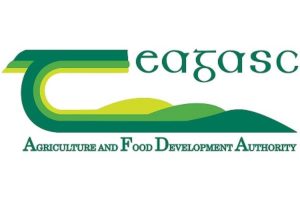
TEAGASC’S NEW MUSHROOM FACILITY AT ASHTOWN
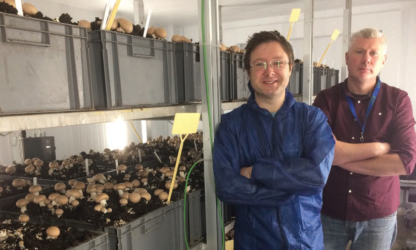 Teagasc’s new mushroom growing facility at the Ashtown campus is now completed and the first experimental crops are being conducted. Dr. Martin O Donoghue is researching how to get the most out of mushroom substrate with the aim of improving yields, and ultimately the efficiency and profitability of mushroom growers. Martin is using the latest molecular technologies to understand how the mushroom breaks down the compost. All fungi use enzymes to break down the complex food sources present in organic matter. In his DAFM funded research project entitled ‘AgGenes’, Martin is identifying all the genes that are switched on and off in the mushroom over the course of a crop. This will enable him to identify key genes and enzymes involved in the process of substrate utilisation and mushroom production. Mushroom breeders are very interested in knowing what these key genes are so they can select for them in their breeding programmes, ultimately producing more efficient mushroom strains for the sector. ✽
Teagasc’s new mushroom growing facility at the Ashtown campus is now completed and the first experimental crops are being conducted. Dr. Martin O Donoghue is researching how to get the most out of mushroom substrate with the aim of improving yields, and ultimately the efficiency and profitability of mushroom growers. Martin is using the latest molecular technologies to understand how the mushroom breaks down the compost. All fungi use enzymes to break down the complex food sources present in organic matter. In his DAFM funded research project entitled ‘AgGenes’, Martin is identifying all the genes that are switched on and off in the mushroom over the course of a crop. This will enable him to identify key genes and enzymes involved in the process of substrate utilisation and mushroom production. Mushroom breeders are very interested in knowing what these key genes are so they can select for them in their breeding programmes, ultimately producing more efficient mushroom strains for the sector. ✽
GCSAI EDUCATION DAY AT TEAGASC ASHTOWN
Colm Dockrell (Teagasc) addressing the delegates
There was a large attendance last month at Teagasc AFRC Ashtown for the Golf Course Superintendents Association of Ireland’s education day. Topics for the morning seminar included; managing turfgrass root systems, golf course tree management and the use of
neonicotinoids in turfgrass management. In his presentation, Colm Dockrell from Teagasc National Botanic Gardens outlined the main functions of the turfgrass root and how the grass plant reacts to various environmental conditions and stresses. Neil MacCrimmon from Grasshopper Tree Care outlined the importance of having a tree maintenance plan for both old and recently planted trees on a golf course. He also addressed the legal obligation for golf course owners to carry out regular surveys on their trees. The last speaker was Dr. Colin Mumford, technical advisor to Bayer Crop Science. His topic was the use of neonicotinoids and in particular imidacloprid for controlling leatherjackets on turf. Because of the danger to bees and other pollinating insects, the use of imidacloprid on flowering crops has been withdrawn. Dr. Mumford stressed the importance of timing when using this product to control leatherjackets in the turf.
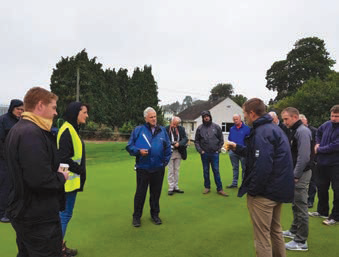
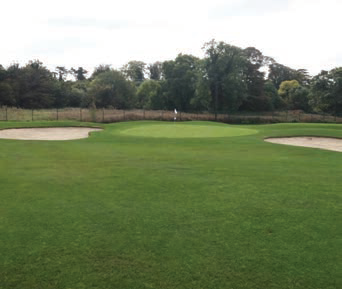
| Teagasc turfgrass training academy |
After lunch, the delegates were brought on a tour of the new turfgrass training academy at Teagasc Ashtown. Construction work on the facility began in March and the grass was sown in early June. The facility, which comprises three golf holes with tee boxes, greens, and bunkers constructed to the most modern specifications, highlights the commitment of Teagasc to turfgrass training in the future. ✽
CARROT HERBICIDE TRIALS
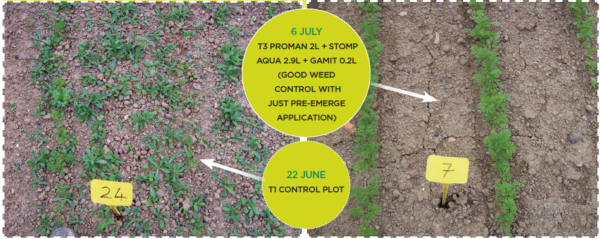
Carrot, celery and parsnip growers are due to lose linuron in the middle of 2018. This has been one of their key herbicides for the past number of decades. What’s proposed to take its place is Proman (metobromuron), a product from Belchim that is already registered for use on potatoes.
Earlier this year Teagasc set up a series of replicated trials at Kinsealy to test out the product against the industry linuron standard, Afalon. The results were encouraging. Proman seemed to work well across all the treatments with no evidence of any damage to the carrots from any of the applications. It also gave excellent results when tank mixed with Stomp Aqua and Gamit. The bottom line is that Proman will turn out to be a suitable substitute for that old stalwart, linuron. Full details are on the Teagasc website under Crops > Horticulture> Vegetables. ✽
DAFM SCHEME OF INVESTMENT
|
| Some key points: ● (New) Planning permission is now a requirement for all building projects. Previously it was enough to have applied for permission. Now a grant of permission is a condition of approval so this should be in place at time of application. ● (New) We understand from DAFM that the application form and business plan have been amalgamated into one document. In other words, the business plan template which we would have supplied to growers to capture key information is now integrated in the application form. ● It is worth remembering that the scheme is a competitive scheme. All eligible items may not necessarily attract investment aid or may attract reduced aid in certain instances. ● Quotations should be recent and need a signature (electronic signature is acceptable). ● Ensure that quotation has adequate information to describe the proposed investment and that VAT is clearly itemised. ● Please consider the priority order of investments, if multiple items are being requested. ● Please ensure that the proposed investment or equipment is horticulture specific. ● Under no circumstances will late applications be accepted by DAFM so contact your Teagasc adviser as early as possible if you require assistance. ✽ |




